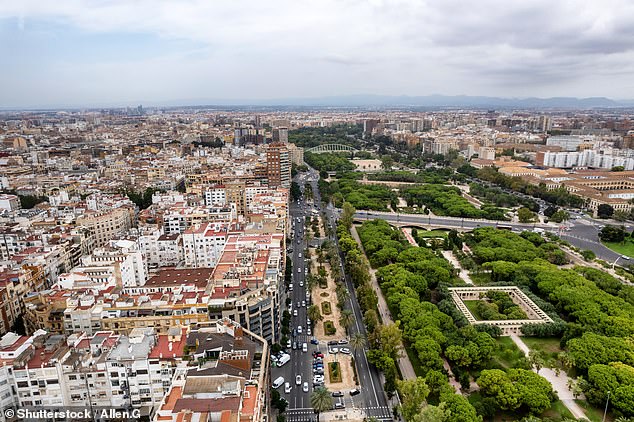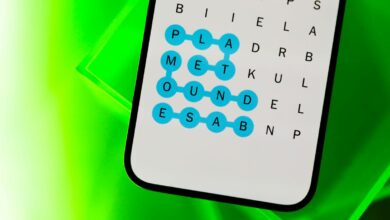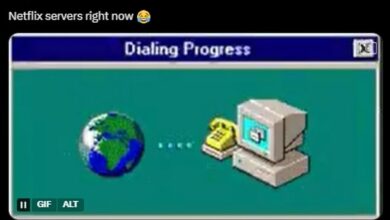I’m from Great Britain and live in Valencia, the European city that Brits love to visit: from housing the Holy Grail to beautiful beaches, here’s what’s so great about it

Valencia is Spain’s third largest city and is used to being overshadowed by the boisterous Barcelona and the smooth Madrid.
But in a Which? the survey unexpectedly came out on top as the European city break destination that British people love most (tied with the equally charming Krakow, in Poland).
With an impressive score of 92 percent, little Valencia beat the better known Stockholm, Seville and Berlin to take first place.
As a Brit who has been lucky enough to live in Valencia for the past five years, my only surprise was why people hadn’t realized the virtues of this beautiful city sooner.
Here are seven reasons why this city should be on the list for your next city break, according to an adopted local, including one that will surprise you…
It has a park that used to be a river

The Turia Gardens (above) are ‘the center of Valencian life’, writes Sarah
There are few cities as green as Valencia, and the crowning glory is a ribbon of greenery that winds for more than eight kilometers through the city.
These are the Turia Gardens, formerly the Turia River before it was diverted after a flood in 1957. Now it is the center of Valencian life.
Stroll among the pine and palm trees and under historic bridges from the 15th century and you’ll find yoga classes, couples in love, impromptu football matches and picnicking families. It’s also the perfect way to explore the city without having to touch a road and a great way to experience the Valencian lifestyle.
It is home to science fiction-worthy architecture

Valencia’s City of Arts and Sciences has appeared in Tomorrowland, Doctor Who and will appear in the second series of Star Wars prequel Andor

Sarah Gordon in her hometown of Valencia
Right at the easternmost point of the Turia Gardens you will find some truly futuristic locations. Large, gleaming white buildings in surreal shapes emerge from the park and the perfect pools of turquoise water. They are home to a 3D cinema, a science museum, an art gallery and an opera house – even an open-air nightclub in the summer months. This is the City of Arts and Sciences, designed by the Valencian architect Santiago Calatrava. You may recognize these unusual buildings from George Clooney’s film Tomorrowland or even from an episode of Peter Capaldi’s Doctor Who.
These buildings also became the city of Delos in Westworld and scenes for the second series of Star Wars prequel Andor were filmed here.
You can cycle everywhere
As you may have already understood from the beautiful park, Valencia is a city where life lives outdoors; after all, it has more than 300 days of sunshine every year.
So what could be better than traveling around on two wheels?

Sarah recommends exploring Valencia by bike, noting that the 200 kilometers of cycle paths connect the center to the beach, park and surrounding villages
This city of less than a million inhabitants has approximately 200 kilometers of cycle paths.
They connect the center with the beach, the park and even the farms and villages that surround Valencia. Rent a bike during your stay and paddle around like the locals.
There are fantastic beaches

The photo above shows why Valencia was voted the British people’s favorite European seaside destination
Yes, Valencia is by Which? voted best city break destination, but in a separate survey it was also voted the British people’s favorite European seaside destination.
It’s easy to see why. This city is located on the Mediterranean coast and is surrounded by golden beaches. Just a few kilometers from the city center (that’s what bicycles are for!) you can enjoy lunch with a sea view. My favorites are Patacona, for its summer beach bars and bohemian atmosphere, or further afield El Saler, for its pristine sands backed by wild dunes and a lush pine forest perfect for a relaxing stroll.
The paella is fantastic

Valencia is the birthplace of paella, says Sarah, who adds: ‘Making it is an art form’
The national dish of Spain was born in Valencia. And real paella is made with rabbit, chicken, green beans and lima beans, sweet pepper, saffron and rosemary. Making it is an art form. It takes about 30 minutes and you have to order for at least two people, but it’s worth it. Beware of the caramelized bit that you almost have to scrape out of the pan, called socarrat. It’s everyone’s favorite part.
Not sure about the paella? No problem.
Valencia is surrounded by farmland (another reason to hop on a bike), which means the restaurants here have the freshest ingredients to work with. Order a whole fish with local vegetables, enjoy delicious tapas dishes with chorizo, coca (a kind of flat bread) with different toppings, or Valencian ratatouille with tuna (titaina) and if you fancy all-i-pebre – a dish with eel , pepper and chili.
You will find the Holy Grail

The Holy Grail is said to be in Valencia Cathedral (above)

This image shows the carved gold reliquary in Valencia Cathedral, said to have been used by Jesus Christ during the Last Supper
Yes, really. It’s been here the whole time. Someone really should have told Dan Brown. Head to the beautiful blue-domed cathedral in the beautiful Gothic center of the city – all winding streets and quirky street art – and you’ll find a small chapel where an agate cup, now decorated with a carved gold reliquary, is the only one used by Jesus Christ during the Last Supper.
The Church explains its claim and why it believes this is the true Holy Grail. You can decide for yourself.
Then head to El Miguelete Tower for stunning views over the city, before heading out to enjoy the sun-drenched squares lined with orange trees and the quaint shops of the old town.
The Fallas festival will leave you awestruck (and slightly deaf).

Towering works of art line the streets during Valencia’s Las Fallas festival (above).
Perhaps one of Spain’s most bizarre festivals, Las Fallas lasts around three weeks each March, but reaches its peak in the last few days before ending on March 19 – so book for those days. Neighborhood groups mount towering statues in the streets with satirical scenes and the city is closed to traffic. You can wander around each neighborhood among free open-air parties, and every day there is a thunderous fireworks display in the town square at 2 p.m.
You’ll see falleros strolling around in regional costume: lush silk dresses and Princess Leia hairstyles for the women and knee-length trousers, shirts and vests for the men.
Then, on the night of the 19th, all the works of art, which took the better part of a year to create and cost a fortune, are burned to the ground. It is said to be a nod to the time when carpenters burned the pieces of wood that supported their lamps in winter to welcome spring.
If you’re still wondering whether Valencia should be your next city break destination, there are plenty of other reasons to visit, from the fantastic al fresco restaurants to the many new boutique hotels (try The Valentia of Yours) and from the friendly locals to the colorful hipster neighborhoods (try Ruzafa and Cabanyal).
Just don’t tell too many people about it, it’s my little secret…




